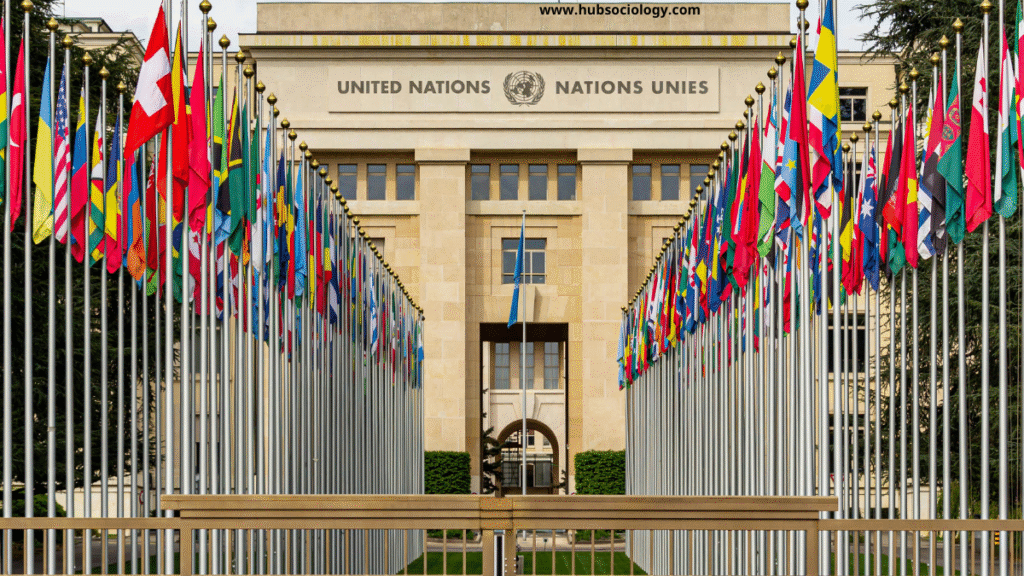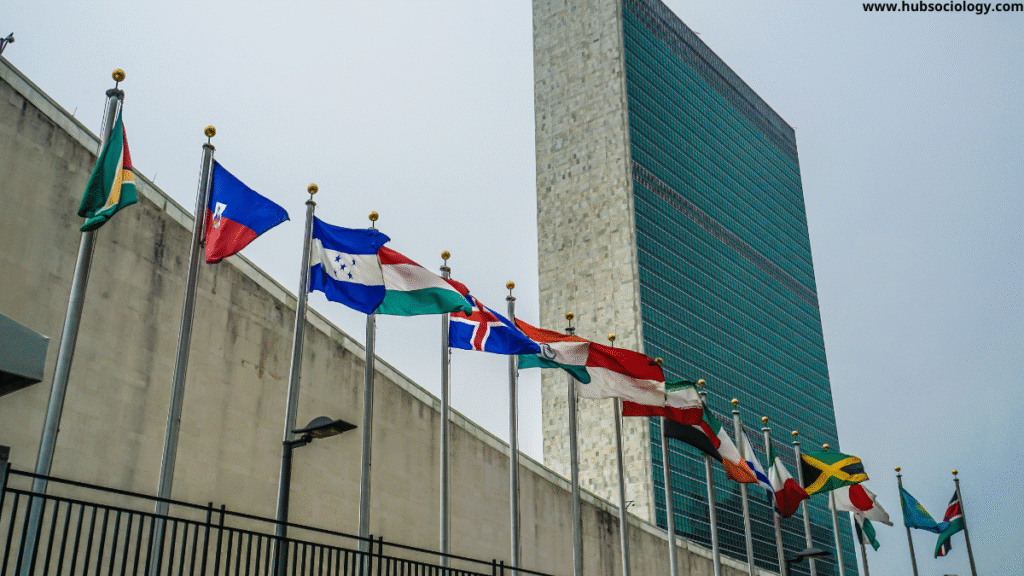Introduction
Population is one of the most critical factors shaping global development, social change, and human welfare. Rapid population growth, uneven demographic distribution, and aging societies have significant implications for employment, health, education, environment, and global inequality. The United Nations (UN), since its establishment in 1945, has played a pivotal role in addressing population-related issues at international, regional, and national levels. Through its specialized agencies, conferences, and policy frameworks, the UN has become a central platform for coordinating population research, promoting reproductive health, and fostering sustainable population policies.
From a sociological perspective, the United Nations role in population matters extends beyond numbers — it involves the study of human behavior, social structures, gender relations, and cultural practices influencing demographic trends.

1. The Sociological Dimension of Population
Sociology views population not merely as a quantitative phenomenon but as a qualitative aspect of social life. Population growth or decline affects and reflects social processes such as family structure, migration, urbanization, gender roles, and education. For instance, high fertility rates are often linked to traditional gender norms, low education levels, and limited access to healthcare. Similarly, declining fertility in developed countries signals changing family values and women’s participation in the workforce.
Thus, from a sociological standpoint, population dynamics are deeply intertwined with social change, cultural values, and economic structures. Recognizing this, the United Nations has adopted a holistic approach to population — one that integrates demographic trends with social development, gender equality, and human rights.
2. Historical Background: UN’s Involvement in Population Issues
The UN’s interest in population issues began soon after World War II, as member nations recognized the need for coordinated demographic data to guide reconstruction and development.
- In 1946, the Population Commission (now part of the Commission on Population and Development) was established to advise the Economic and Social Council (ECOSOC).
- In 1947, the Population Division within the UN Department of Economic and Social Affairs (UNDESA) was created to collect, analyze, and disseminate demographic data globally.
- The United Nations Population Fund (UNFPA) was founded in 1969 (initially as the UN Fund for Population Activities) as the main agency to support countries in implementing population and reproductive health programs.
These institutional foundations allowed the UN to promote demographic research, support censuses, and advocate for family planning as an integral component of development policy.
3. Major UN Conferences on Population
The UN organized several landmark international conferences that shaped the global understanding of population in sociological and developmental contexts:
(a) World Population Conference, Rome (1954)
This was the first major global forum to bring scientists and policymakers together to discuss population growth. It recognized the need for demographic data and research but was largely technical in focus, without a strong sociological or ethical dimension.
(b) Belgrade Conference (1965)
This meeting expanded the focus from purely demographic statistics to population policies and social implications. It acknowledged the connection between population growth and economic development.
(c) Bucharest Conference (1974)
The World Population Plan of Action was adopted, emphasizing that population policy must be integrated into development planning. The slogan “Development is the best contraceptive” reflected the sociological insight that social and economic progress naturally leads to lower fertility rates.
(d) Mexico City Conference (1984)
This conference debated controversial issues like abortion and reproductive rights, highlighting the tension between moral values, religious beliefs, and social policy.
(e) International Conference on Population and Development (ICPD), Cairo (1994)
A historic turning point, the Cairo conference shifted the global focus from population control to reproductive health, gender equality, and human rights. The ICPD Programme of Action recognized that empowering women and ensuring access to education and healthcare are key to sustainable population management. This sociological reorientation emphasized individuals’ rights and social development rather than numerical targets.
4. UN Agencies Working in the Field of Population

(a) United Nations Population Fund (UNFPA)
UNFPA is the primary UN agency addressing population issues. Its mission focuses on ensuring reproductive health and rights, promoting family planning, reducing maternal mortality, and supporting gender equality. It assists governments in collecting demographic data and implementing population policies that are socially sustainable and culturally sensitive.
(b) United Nations Department of Economic and Social Affairs (UNDESA)
The Population Division of UNDESA provides critical demographic data and projections that guide policymaking. Its World Population Prospects reports are globally recognized references for population trends.
(c) World Health Organization (WHO)
WHO collaborates with UNFPA to improve maternal and child health, reproductive health, and family planning services, addressing population issues from a public health perspective.
(d) United Nations Educational, Scientific and Cultural Organization (UNESCO)
UNESCO contributes by promoting education, gender equality, and research on population education — emphasizing the sociological link between knowledge, social awareness, and demographic behavior.
5. UN’s Population Policies and Sociological Implications
The UN’s population policies reflect an understanding that demographic change is rooted in social behavior. Its approach integrates the following sociological aspects:
(a) Gender Equality and Empowerment of Women
Women’s education, employment, and reproductive rights are central to the UN’s population agenda. The empowerment of women not only reduces fertility rates but also transforms traditional patriarchal structures and family relations.
(b) Reproductive Health and Rights
By promoting universal access to reproductive healthcare, the UN supports individuals’ autonomy and dignity. This marks a shift from state-centered population control to people-centered population welfare — a major sociological evolution.
(c) Youth and Social Change
The UN addresses the role of youth in demographic transitions. Through education and employment initiatives, it aims to harness the demographic dividend — turning a young population into a social and economic asset.
(d) Migration and Urbanization
The UN studies migration patterns, their causes, and their impact on families, communities, and social cohesion. It encourages member states to adopt migration policies that respect human rights and foster multicultural integration.
(e) Aging Population and Intergenerational Solidarity
As many societies face aging populations, the UN advocates policies to promote intergenerational support, active aging, and social protection systems — sociologically vital for maintaining community balance.
6. The Role of Research and Data
Reliable demographic data are the backbone of population policy. The UN’s World Population Prospects, World Urbanization Prospects, and Demographic Yearbook offer valuable insights into trends such as fertility decline, migration, and mortality. These data not only inform policy but also enable sociologists to analyze population processes in relation to social stratification, family systems, and cultural transformation.
7. Challenges Faced by the UN in Population Efforts
Despite significant progress, several challenges persist:
- Cultural and religious resistance to family planning and reproductive rights.
- Political controversies over abortion, migration, and gender identity.
- Economic inequalities that perpetuate high fertility and poor health outcomes.
- Climate change and displacement, which add new dimensions to population studies.
These challenges illustrate that population issues cannot be solved through technical means alone; they require sociological understanding and social cooperation.
8. The UN and Sustainable Development Goals (SDGs)
The 2030 Agenda for Sustainable Development integrates population concerns into its 17 goals, especially:
- Goal 3: Ensure healthy lives and promote well-being for all (maternal and child health).
- Goal 5: Achieve gender equality and empower all women and girls.
- Goal 10: Reduce inequality within and among countries.
The UN’s holistic approach links population dynamics with social justice, equality, and environmental sustainability — all central concerns of modern sociology.
Conclusion
The United Nations has evolved from focusing on population control to advocating for human-centered development. Its efforts recognize that population is not merely a matter of numbers but a reflection of human relationships, social institutions, and cultural patterns. From the perspective of sociology, the UN’s work in population illustrates how demographic change is inseparable from social change.

Through education, empowerment, and global cooperation, the UN continues to shape a world where population policies respect human dignity, promote equality, and ensure that demographic transitions contribute to sustainable and inclusive societies.
Do you like this this Article ? You Can follow as on :-
Facebook – https://www.facebook.com/hubsociology
WhatsApp Channel – https://whatsapp.com/channel/0029Vb6D8vGKWEKpJpu5QP0O
Gmail – hubsociology@gmail.com
Topic related question
5 Marks Questions (Short Answer Type)
- What is the main role of the United Nations in population studies?
- Write a short note on the establishment of the United Nations Population Fund (UNFPA).
- What was the key outcome of the 1994 International Conference on Population and Development (ICPD) in Cairo?
- How does the UN link population policies with human rights?
- Mention any two UN agencies working in the field of population and their main functions.
- What is the sociological importance of population data collected by the UN?
- How does the UN address gender equality in population policies?
10 Marks Questions (Medium Answer Type)
- Discuss the evolution of the United Nations’ role in global population policy since 1945.
- Explain the sociological dimensions of the UN’s population policies with special reference to gender equality and reproductive health.
- What are the major objectives and functions of the United Nations Population Fund (UNFPA)?
- Evaluate the impact of major UN Population Conferences (1974 Bucharest, 1984 Mexico City, and 1994 Cairo) on international population policy.
- Discuss the challenges faced by the United Nations in implementing population-related programs in developing countries.
15 Marks Questions (Long Answer / Essay Type)
- Critically analyze the role of the United Nations in the field of population from a sociological perspective.
Highlight how UN initiatives reflect changes in social values, gender relations, and human development. - Examine the contribution of UNFPA and other United Nations agencies in promoting sustainable population policies worldwide.
Include discussion on reproductive rights, family planning, and demographic research. - Discuss the shift in United Nations population policy from population control to human-centered development.
Explain this transition using the 1994 Cairo Conference as a turning point. - Evaluate how the United Nations population programs address key sociological issues such as migration, urbanization, and aging.
- Explain how the UN’s population agenda aligns with the Sustainable Development Goals (SDGs) and promotes social justice and equality.
